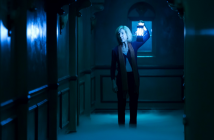Editor’s Notes: The following review is part of our coverage of the 2015 Vancouver International Film Festival. For more information on the festival visit viff.org and follow VIFF on Twitter at @viffest.
A striking cinematic experiment, Zhang Lu’s divisive Love and… is both an homage to and a deconstruction of cinema, with its four episodic chapters subtly working towards a profound, accumulative end. With sincerity and a palpable love of cinema, Lu’s film presents multiple layers of films within films, with the first chapter happening to be the product of a film about love. This episode is intentionally trite, convoluted, and pretentious. It uses black and white photography, appears artistic, and uses highly conventional TV-like framings which, frankly, most audiences are sick of. It tells a story, but has no cinematic depth, and does little to elicit genuine emotions in the audience. This first chapter has one considering walking out on the film; fortunately, the chapter is given meaning as the film carries on, leading to a fourth chapter which literally reinstates the same film within the film—this time with cinematic proficiency.
After the director yells cut, there is a brilliant shift from black and white to colour as the film within a film ends. A gaffer approaches the director to tell him he doesn’t know how to film love, that his filmmaking does not convey love—“you don’t know what love is,” he claims. He dramatically exits the studio, taking a film reel with him as he leaves, and the camera slowly tracks towards a serene body of water while an off-screen fire crackles his burning film.
Chapters two and three quite practically serve as a tutorial on filmmaking. Lu uses these episodes to show the audience authentic cinematography. The second episode, entitled “film”, is an avant-garde experiment of cinematography, wherein a camera observes settings and objects with a purely audio-visual intention. There is no story to chapter two, besides the Tarkovsky-inspired use of poetry. This segues into chapter three which involves multiple films within the film. In particular, scenes from Memories of Murder are seen, absent of a soundtrack, with silent-film-like intertitles showing new dialogue for the material. The film deconstructs the use of actors within cinema, perhaps suggesting that actors exist as part of the script and not as part of cinematography, the latter being particularly essential in conveying invisible forces such as love.
Once Lu’s tutorial has completed, the first episode is replayed, but with great variation. The actors have been rejected entirely; it is shot in colour; the cinematography is unique and meticulously crafted. While we hear the exact dialogue of the first chapter on love, the fourth chapter on love shows only objects, filmed similarly to the avant-garde exercise of chapter two. There is a scene wherein a red and blue chair come closer and meet in the middle as we hear dialogue between the two presumed actors. The absence of their bodies powerfully attests to their bond as father and daughter since the meeting of chairs speaks on a metaphorical and thus limitless level. This is the most profound aspect of cinema: that it can convey metaphysical qualities such as love. Lu ensures that we understand that this may only be done poetically, not through the limited avenue of narrative storytelling.
A striking cinematic experiment, Zhang Lu’s divisive Love and… is both an homage to and a deconstruction of cinema, with its four episodic chapters subtly working towards a profound, accumulative end.




